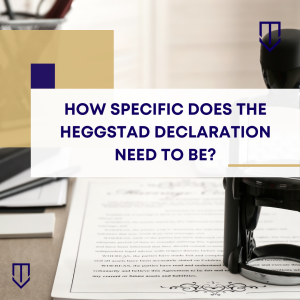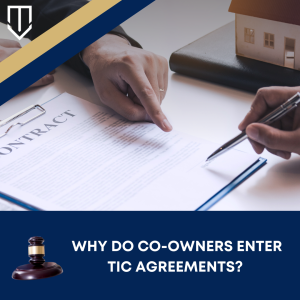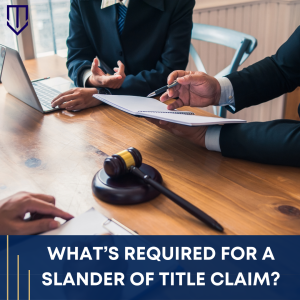 A Heggstad petition is a unique legal maneuver in probate court that a party can use to establish the existence of a trust. Normally, if a party wants to show that the property at issue is in a family trust, they have to produce evidence of a transfer of the property into the trust. (Prob. Code § 15200 (b).) This is usually accomplished with a deed, which conveys the property from the owners (the “settlors”) to the trustees of the trust.
A Heggstad petition is a unique legal maneuver in probate court that a party can use to establish the existence of a trust. Normally, if a party wants to show that the property at issue is in a family trust, they have to produce evidence of a transfer of the property into the trust. (Prob. Code § 15200 (b).) This is usually accomplished with a deed, which conveys the property from the owners (the “settlors”) to the trustees of the trust.
But what happens when the settlor and trustee are the same person? That’s where Heggstad comes in. Under Heggstad, no formal transfer of the property by deed is needed. Instead, a written declaration of trust by the owner of the property is enough, provided the owner names themself as the sole trustee. (Carne v. Worthington (2016) 246 Cal.App.4th 548, 559.)
Nonetheless, a successful Heggstad petition still requires proper planning and execution. A faulty property description, for instance, can doom the action from the outset. At Underwood Law firm, our attorneys know how tough a situation like this can be. Thankfully, our attorneys are well-versed in estate planning, and we know the best ways to tackle the disputes that accompany property in probate. Our team has the legal acumen and skills necessary to help you achieve your litigation goals.
 California Partition Law Blog
California Partition Law Blog


 An action for accounting is an equitable action seeking to determine the amount owed to the parties of an action when damages are uncertain. “An accounting is an equitable proceeding which is proper where there is an unliquidated and unascertained amount owing that cannot be determined without an examination of the debits and credits on the books to determine what is due and owing.” (
An action for accounting is an equitable action seeking to determine the amount owed to the parties of an action when damages are uncertain. “An accounting is an equitable proceeding which is proper where there is an unliquidated and unascertained amount owing that cannot be determined without an examination of the debits and credits on the books to determine what is due and owing.” ( A
A  A deed of trust is a commonly used mortgage document in California. Essentially, a deed of trust provides a lender with security for the repayment of the loan and effectively functions
A deed of trust is a commonly used mortgage document in California. Essentially, a deed of trust provides a lender with security for the repayment of the loan and effectively functions  A “TIC” Agreement is a contractual agreement between tenants in common to real property. Because each tenant in common is a co-owner of the property, these agreements can help spell out the rights of each, preventing future disputes over payment or occupation. And, if the dispute cannot be prevented, the agreement, acting as a binding contract, provides a clear guideline for a judge to use in a court action, ensuring that the lawsuit moves along as quickly as possible.
A “TIC” Agreement is a contractual agreement between tenants in common to real property. Because each tenant in common is a co-owner of the property, these agreements can help spell out the rights of each, preventing future disputes over payment or occupation. And, if the dispute cannot be prevented, the agreement, acting as a binding contract, provides a clear guideline for a judge to use in a court action, ensuring that the lawsuit moves along as quickly as possible.  In California, a person can claim title to a piece of real property that they are not a titleholder to through adverse possession. Adverse possession requires a person to be in use of a particular piece of real property for the required statutory period. An adverse possessor, however, does not become the titleholder of a piece of property merely by using the property. Certain elements are required for a claimant to acquire title through adverse possession. The requirements for adverse possession are codified in the California Code of Civil Procedure section 323.
In California, a person can claim title to a piece of real property that they are not a titleholder to through adverse possession. Adverse possession requires a person to be in use of a particular piece of real property for the required statutory period. An adverse possessor, however, does not become the titleholder of a piece of property merely by using the property. Certain elements are required for a claimant to acquire title through adverse possession. The requirements for adverse possession are codified in the California Code of Civil Procedure section 323. A motion to determine title is a motion to the court requesting that the court establish title to a piece of real property. Typically, a motion to determine title shows up in the court as a quiet title action. A quiet title action is brought when a litigant seeks to establish that they have an ownership interest in the subject property and refute any adverse claims against the litigant. It follows that to prevail on a motion to determine title; one must show that they hold some ownership interest in the subject property.
A motion to determine title is a motion to the court requesting that the court establish title to a piece of real property. Typically, a motion to determine title shows up in the court as a quiet title action. A quiet title action is brought when a litigant seeks to establish that they have an ownership interest in the subject property and refute any adverse claims against the litigant. It follows that to prevail on a motion to determine title; one must show that they hold some ownership interest in the subject property.  When there are two or more owners of a piece of real property who are unable to come to an agreement on how to divide the property, any co-owner of the subject property may petition the court to partition the property. This is known as a partition action. Generally, the decision of a court to partition the property is merely the first step in the partition process. Although a partition action may sound quite simple, it is a complex process that requires extensive accounting and patience.
When there are two or more owners of a piece of real property who are unable to come to an agreement on how to divide the property, any co-owner of the subject property may petition the court to partition the property. This is known as a partition action. Generally, the decision of a court to partition the property is merely the first step in the partition process. Although a partition action may sound quite simple, it is a complex process that requires extensive accounting and patience.  Slander of title is quite the unique cause of action. As the name implies, it involves defamatory or slanderous activity but not against any person or personal interest. Instead, a slander of title involves activity that calls the state of your title into doubt (by, for example, filing an unwarranted lis pendens) that diminishes the value of your property.
Slander of title is quite the unique cause of action. As the name implies, it involves defamatory or slanderous activity but not against any person or personal interest. Instead, a slander of title involves activity that calls the state of your title into doubt (by, for example, filing an unwarranted lis pendens) that diminishes the value of your property.  In most cases, no. Instead, the statute of limitations most frequently bars a partition action when a party’s rights to the property have lapsed due to an ouster.
In most cases, no. Instead, the statute of limitations most frequently bars a partition action when a party’s rights to the property have lapsed due to an ouster.